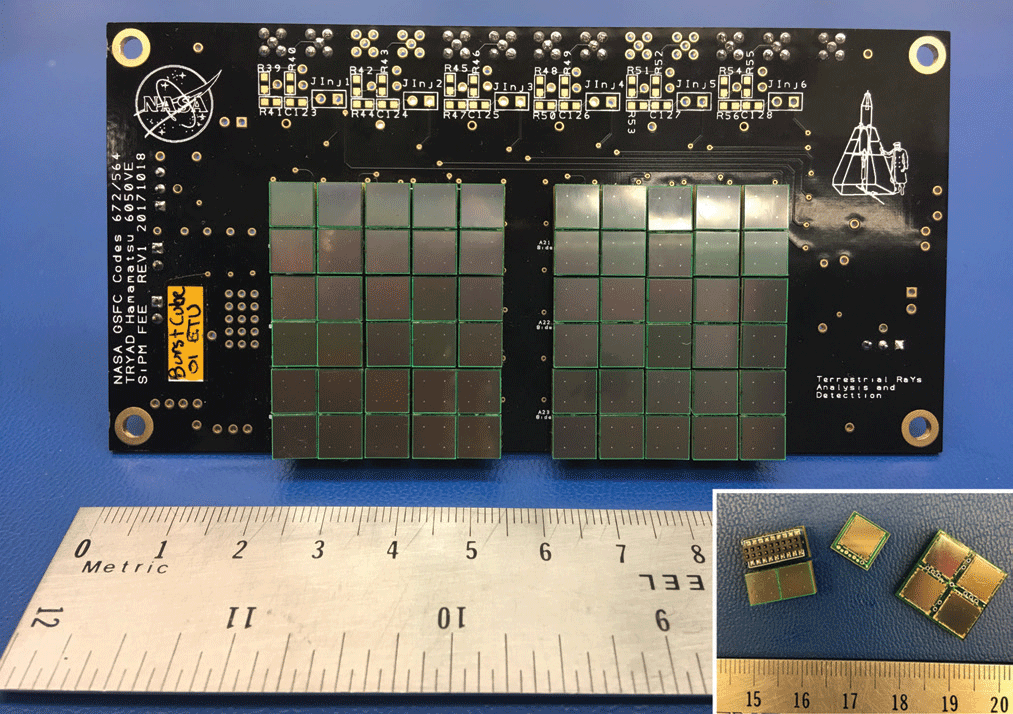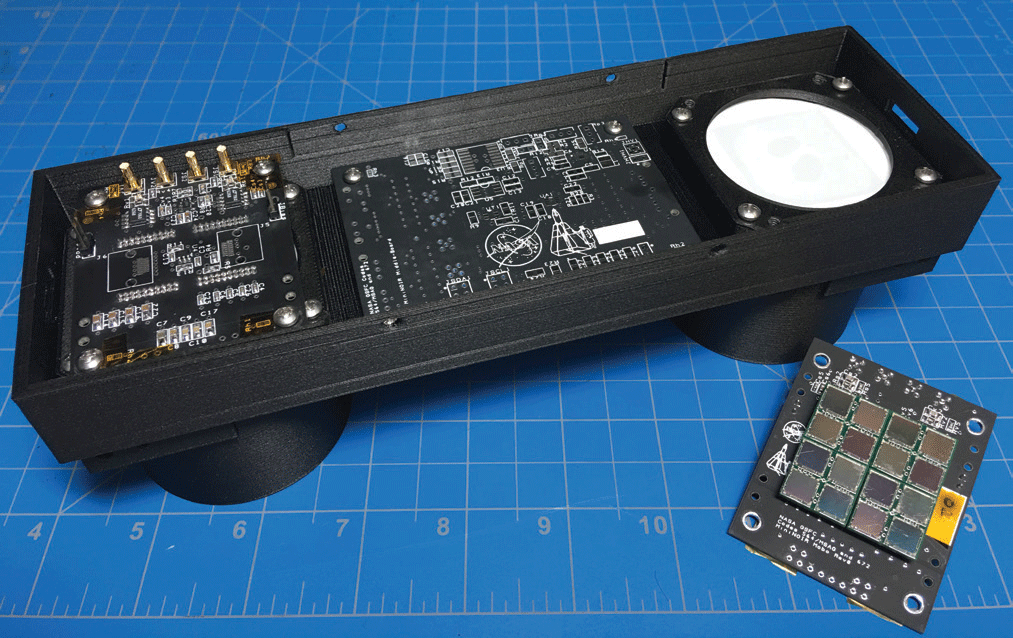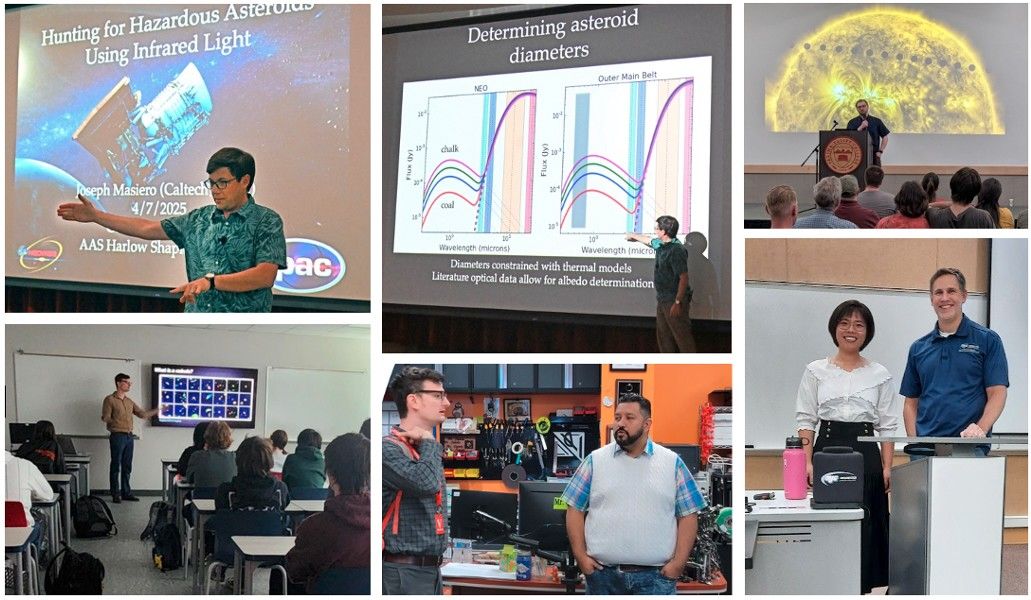Technology Development
A team of scientists and engineers at Goddard Space Flight Center is developing innovative technologies to expand the opportunities for neutron and gamma-ray detection from space on small satellite platforms. Traditional space-based detectors, such as the Gamma-ray Burst Monitor (GBM) on NASA’s Fermi Gamma-ray Space Telescope, cannot detect events that occur in parts of the sky blocked by Earth. Employing detectors on small platforms like CubeSats will permit observations to be gathered throughout the entire sky. To fit on a CubeSat, however, these detectors must have reduced mass, volume, power, and cost.
One enabling technology includes development of large-area arrays of silicon photomultipliers (SiPM)—active detectors composed of modern scintillating materials. New scintillator materials, including both solid organic and inorganic crystals, can be grown commercially in large volumes and provide improved light output and pulse shape discrimination, which is used to distinguish neutrons from gamma rays. SiPMs consist of two-dimensional arrays of small (~50 μm) photodiode cells that are read out in parallel and provide high gain, fast output, and 20-40% detection efficiency. By tiling SiPMs together into scalable large-area arrays, the GSFC team has been able to design highly adaptable readout devices with applications in heliospheric, planetary, and astrophysics disciplines, in addition to commercial, defense, and security applications.
The capabilities of these large-area SiPM arrays have generated great interest, particularly for CubeSat applications. In early 2018, the GSFC team will deliver flight-ready large-area SiPM arrays and front-end electronics (FEE) to the University of Alabama in Huntsville for the National Science Foundation-funded CubeSat mission, Terrestrial RaYs Analysis and Detection (TRYAD), which will measure terrestrial gamma rays associated with lightning.
Later in 2018, the team will be delivering a neutron spectrometer, the Ionospheric Neutron Content Analyzer (INCA), for a New Mexico State University (NMSU) CubeSat. Students at NMSU are building and testing the 3-unit (3U) spacecraft bus and will integrate the NASA-developed instrument in 2018. INCA employs a two-cell configuration of modern scintillators that incorporate the SiPM arrays, FEE, and a waveform-capture, application-specific integrated circuit (ASIC) to obtain excellent separation between neutrons and gamma rays.
The use of these large-area arrays has extended to an exciting new area in astrophysics with a recent CubeSat award from NASA’s APRA program. The GSFC team is currently working to develop an instrument to support BurstCube, a mission specifically targeted to search for the gamma-ray counterpart to gravitational waves. The BurstCube instrument will involve four blocks of cesium-iodide crystals, operating as scintillators in different orientations within the spacecraft. When an incoming gamma ray strikes one of the crystals, it will absorb the energy and luminesce, converting that energy into optical light. Four large-area arrays of SiPMs and their associated read-out devices each sit behind the four crystals. The SiPMs will convert the light into an electrical pulse and amplify the signal. This multiplying effect makes the detector far more sensitive to faint and fleeting gamma rays.
Impact
Given NASA’s strategic goal to support technology miniaturization and the increased access to space provided by CubeSats and other small satellite platforms, the Agency has devoted significant effort the past several years to develop low-power, compact instrumentation that conforms to small satellite platforms. State-of-the-art packaging of SiPMs into large-area arrays functionally replaces bulky high-voltage photomultipliers. In addition, the team is also exploring advanced, custom, low-power, miniaturized ASICs to provide waveform digitization and time-of-flight measurements that make cost-effective, small satellite technologies accessible to diverse detector configurations.
Future Plans
In addition to the SiPM technology described above, the team is developing an entirely new detection technique based on a fine-grain imaging capability using multi-anode micro-channel plate photomultipliers (MCP-PMT). The fine pitch of MCP-PMT anodes, when matched to orthogonally stacked scintillator fibers, provides the ability to image neutrons by tracking the secondary protons produced by neutrons interacting within the scintillating fiber bundle.
Sponsoring Organization
This work is supported by the Heliophysics Division’s H-TIDeS program, the Astrophysics Division’s APRA program, Goddard’s Internal Research and Development program, and the National Science Foundation. Dr. G. A. de Nolfo at Goddard leads this project with engineers G. Suarez and J. DuMonthier.



































